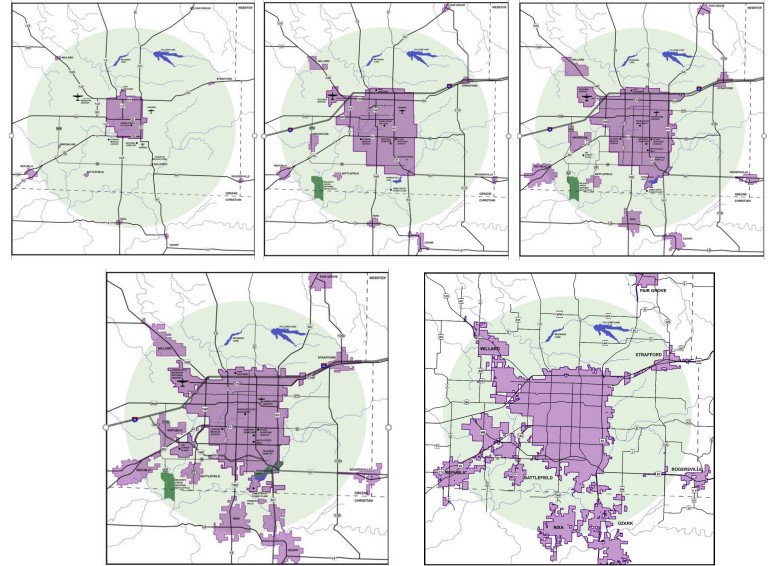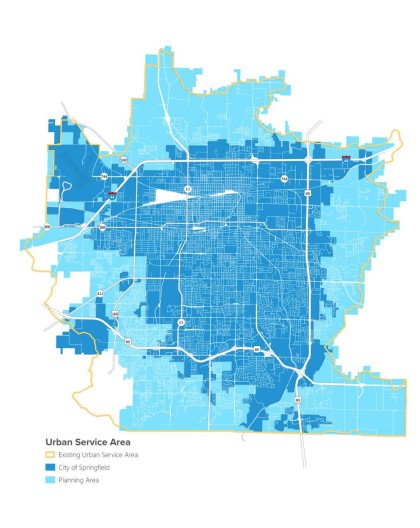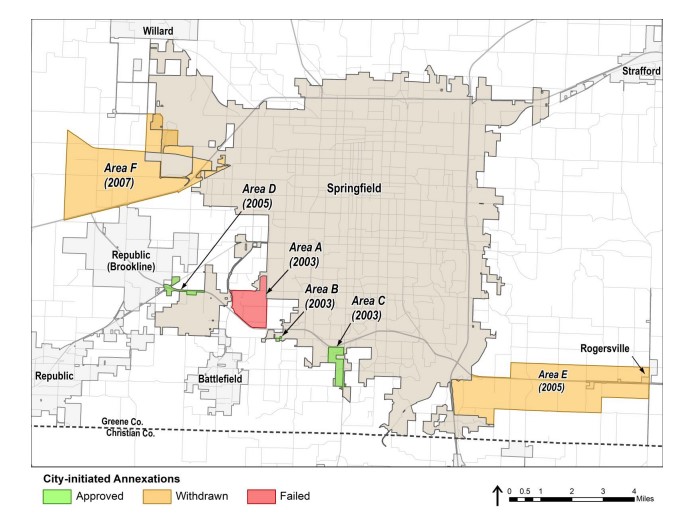As surrounding suburbs continue to grow, Springfield’s geographical growth hangs in the balance with challenging and limited annexation opportunities.
That is why Springfield City Manager Jason Gage, staff members from several city government departments and representatives from City Utilities gave a lengthy presentation on growth and annexation to city council members at a retreat at the Lake Springfield Boathouse on July 18.
“In the end, we need strong City Council consensus,” Gage told the council members. “It’s important for us as a staff to have a good idea of what you as a council, as a body, how you would like us to go about some of this.”
Springfield’s history of annexation
To understand Springfield’s present day geography, Gage provided a historical context of Springfield’s growth, dating back to its consolidation with North Springfield.
Springfield’s most significant growth occurred between 1953 and 1976, following the passage of the Sawyer Act. The Missouri law required declaratory judgment from a circuit court on the validity of annexations, in addition to elections in the city and annexation area. During this period of time, Springfield grew from 17.57 square miles to 64.88 square miles.
Springfield has continued to grow, but at a slower pace, in both total land area and population. Since 1976, the city has grown to 83.98 square miles. There have been annexation opportunities that have fallen through.

While growth boundary agreements with surrounding communities illustrate continued opportunities for Springfield’s city limits to expand, constraints remain, especially with the rapid suburban growth of unincorporated Greene County.
Gage’s primary long-term concern is the possibility of Springfield being “totally belted in by incorporated growth and have no geographic place to go.”
He used St. Louis’ separation from St. Louis County as an example of how being “belted in” can challenge or stop a city’s growth. Gage acknowledges other factors contributed to St. Louis’ population decline from more than 850,000 people in 1950 to less than 300,000 today.
Statutory, city service and community concerns complicate growth
With growth boundary agreements aside, annexation is limited due to statutory requirements, utility and service considerations and other concerns.
City Utilities, city attorneys, Springfield Environmental Services, the Springfield Department of Public Works, the Springfield police and fire departments and others provided council members an overview of the implications and limitations of annexation on their services.
State statute categorizes annexations as either voluntary or involuntary, the latter of which requires an election. While an annexation might grow a city’s tax base, it presents challenges for city departments — from the expansion of coverage areas for emergency services to ensuring properties are developed to meet code standards.
“There is a cost to growth,” Gage said.
“Annexation should be strategic and it's going to take a lot of analysis…but ultimately it has to provide a fiscal benefit to the city,” principal planner Randall Whitman said.
The following objectives to managing growth were listed in the presentation:
- Maximize development in urbanized portions of Springfield through market-responsive regulations and infrastructure upgrades;
- Prioritize maintenance and upgrades to existing infrastructure over the installation of new infrastructure;
- Limit the extension of infrastructure to those areas designated for development in the Land Use Plan.
The presentation also outlined if it was important to consider if an annexation would open up other land for strategic annexation.

The city has priority areas for annexation, and their projected future placetype across its urban service area map. The map illustrates opportunistic areas where coordination, particularly with the government of Greene County, is needed to prevent premature development. The map shares similar — though not entirely the same — boundaries as that of Springfield’s growth boundary agreement.
Priority 1 areas are situated west and south and Priority 2 southeast and northeast of the city, with the remaining amount of land in the urban service area listed as Priority 3.
Sewer project, council consensus on annexations vital for future growth
For Gage and the rest of the city staff, getting consensus on annexation on some level was “really important,” in order for the city to begin planning for future annexations, including land around the Hunt Branch Trunk Sewer project southeast of Springfield.
The project was originally a part of the city’s previous comprehensive plan, Vision 2020, and put on hold during the Great Recession. It will provide a significant opportunity for growth between Springfield’s current city limits and Rogersville, through the building up of sewer and eventually, other public infrastructure improvements.
After relaunching negotiations in 2017, the city eventually acquired all necessary easements to begin the project in 2021.
“This area is highly important to the future of the city because it gives us an opportunity to connect and have what could be at some point in the future, a much larger area inside our city limits, which will give us some additional business but also an opportunity for increasing population,” Gage said.
While council members had questions, concerns and ideas of how Springfield could grow through annexation, they were receptive to the idea of how vital strategic annexation was for the future of Springfield.
Mayor Ken McClure concluded that the city needed to be “deliberate” with annexations, which he said are critical for the city’s long-term future.


